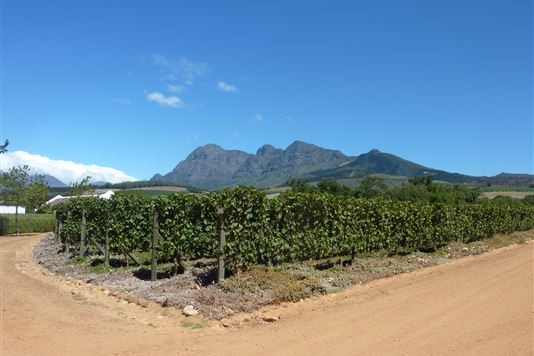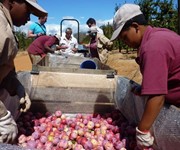loveFOOD visits South Africa Part 1

In the first part of an exclusive diary, Charlotte reports from the farms that supply much of our supermarket fruit.
We at loveFOOD pride ourselves on taking to the road to unearth foodie towns far away from our London HQ. But why stop at Britain? Editor Charlotte is in South Africa all this week, exploring a very different food culture. Here’s her diary so far.
Sizzling South Africa
Never having been to the southern hemisphere before, I was shocked (albeit naively) when we touched down in a blisteringly hot Cape Town on Sunday morning. Heathrow had been a fresh 10°C 11 hours earlier, compared to highs of 38°C here.
That’s been the key factor during my visit so far. It’s easy to forget that, when we Brits are cowering in front of pub fires, there’s a whole other hemisphere enjoying summertime. South Africa at this time of year is medicinally warm, balmy and breezy, with endless blue skies and clear, starry nights. It’s the perfect climate for growing vibrant stone fruits, olives, avocadoes, macadamia nuts, lychees, and anything else that’s colourful.
Winter or summer?
Do you ever eat plums in the British winter time? Or peaches, perhaps? The evidence suggests not. On Monday I met with Mariette Kotze from Hortgro (a trade body representing South African fruit farmers), who told me that the UK demand for South African-grown stone fruits (that is, any fruit with a single stone inside it) and top fruits (apples and pears) is four times higher in our summer than it is in our winter. We associate juicy plums and nectarines with sunny picnics, and assume that to eat such exotic fruit when it’s cold outside would somehow be ‘unseasonal’.
 I visited Babylonstoren in the Drakenstein Valley on Monday, which is one of the oldest Cape Dutch farms, where the plum trees were being harvested. Though still firm, the plums tasted extraordinary and the latest load will be sailing to Europe soon, ripening on the journey. A huge 99% of South African fruit exports are shipped (boats use six times less energy than aeroplanes), and the ripening process is controlled only by temperature, never chemicals.
I visited Babylonstoren in the Drakenstein Valley on Monday, which is one of the oldest Cape Dutch farms, where the plum trees were being harvested. Though still firm, the plums tasted extraordinary and the latest load will be sailing to Europe soon, ripening on the journey. A huge 99% of South African fruit exports are shipped (boats use six times less energy than aeroplanes), and the ripening process is controlled only by temperature, never chemicals.
Geographically speaking, South Africa is the closest winter-time fruit producer to the UK – it’s a shipping time of no more than 14 days, compared to around 21 days for fruit from Chile, the next viable producer.
The time for apples
One of my companions on this Western Cape trip is food blogger and ‘supper club’ innovator Kerstin Rodgers (otherwise known as Ms Marmite Lover). Tweeting our conversation with Hortgro about apples (which account for 56% of South Africa’s total fruit production), she got a tweet from a perturbed follower: “Why is the UK importing South African apples when we grow so many of our own?” Well, the South African apple season (that’s varieties such as Granny Smith, Golden Delicious, Fiji, and Royal Gala) starts in March, which coincides neatly with the end of the British apple season. British supermarkets will buy British produce if it’s available, only when it isn’t will they stock fresh fruit and vegetables from abroad.
A farming community
 Like many other South African farms, Babylonstoren is run in the most unique way: the farmer gives his/her permanent workers a house to live in (pictured), all the necessary utilities, a hot lunch every day, on-site schools for their children, healthcare and a pension, all for free.
Like many other South African farms, Babylonstoren is run in the most unique way: the farmer gives his/her permanent workers a house to live in (pictured), all the necessary utilities, a hot lunch every day, on-site schools for their children, healthcare and a pension, all for free.
But although the wages are just above the recently introduced government minimum (around 130 Rand a day, compared to the minimum wage of 105 Rand), that still works out to be a pitiful £7.20-or-so per day. I spent that on a small bar of chocolate and a bracelet in the town of Stellenbosch today, which gives you an idea of how difficult it would be to, say, save for a house on that kind of salary. But then again, with unemployment in South Africa pushing 30%, perhaps any kind of job is a godsend here. And remember, not all the staff on these farms are permanent – about half of the workforce is seasonal staff, who live in the surrounding townships.
 The South African way of doing things gives those workers previously disadvantaged during apartheid absolute social security, with what seemed like no expense spared. The bungalow-style houses were nicely designed with generous room sizes and an ample garden. Both the crèche and school were modern and colourful, with some of the happiest-looking pupils I’ve ever seen, and everywhere was so clean and tidy. But, because of the poor wages across the whole of South Africa, those families living and working on the farm are likely tied into it for years – generations, perhaps.
The South African way of doing things gives those workers previously disadvantaged during apartheid absolute social security, with what seemed like no expense spared. The bungalow-style houses were nicely designed with generous room sizes and an ample garden. Both the crèche and school were modern and colourful, with some of the happiest-looking pupils I’ve ever seen, and everywhere was so clean and tidy. But, because of the poor wages across the whole of South Africa, those families living and working on the farm are likely tied into it for years – generations, perhaps.
Dilemmas
Having said that, there are government-operated schemes that are trying to tackle this issue: the Black Economic Empowerment (BEE) programme, for example, aims to correct the racial balance in high-profile jobs, by giving disadvantaged groups economic privileges previously not available to them. It’s been a controversial policy though. Critics have commented that it’s designed to encourage the advantaging of the previously disadvantaged (in essence, black South Africans); and in turn encourage the disadvantaging of the previously advantaged (the white South Africans).
 Aside from plum farms and debates about South Africa’s future, much of my mind so far has been on ‘koeksisters’ (pictured) – a ludicrously moreish doughnut-type treat, made from deep-fried dough dipped in sugar syrup. Absolutely divine.
Aside from plum farms and debates about South Africa’s future, much of my mind so far has been on ‘koeksisters’ (pictured) – a ludicrously moreish doughnut-type treat, made from deep-fried dough dipped in sugar syrup. Absolutely divine.
Kerstin Rodgers has now made her own and shared the recipe with loveFOOD - tuck in!
Click here for the second instalment of Charlotte's South Africa trip.
You might also like
loveFOOD visits South Africa Part 2
South African chef Reuben Riffel's recipes
Comments
Be the first to comment
Do you want to comment on this article? You need to be signed in for this feature